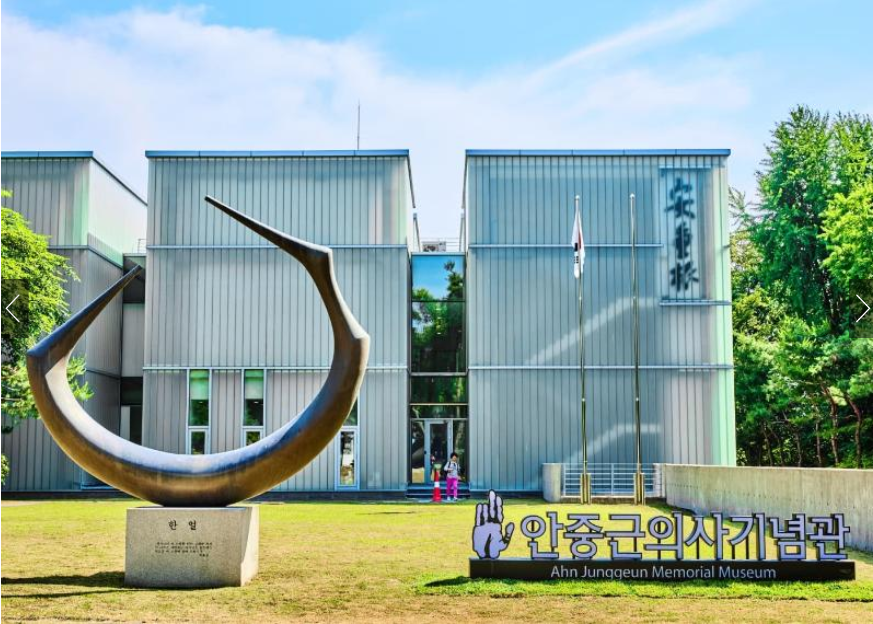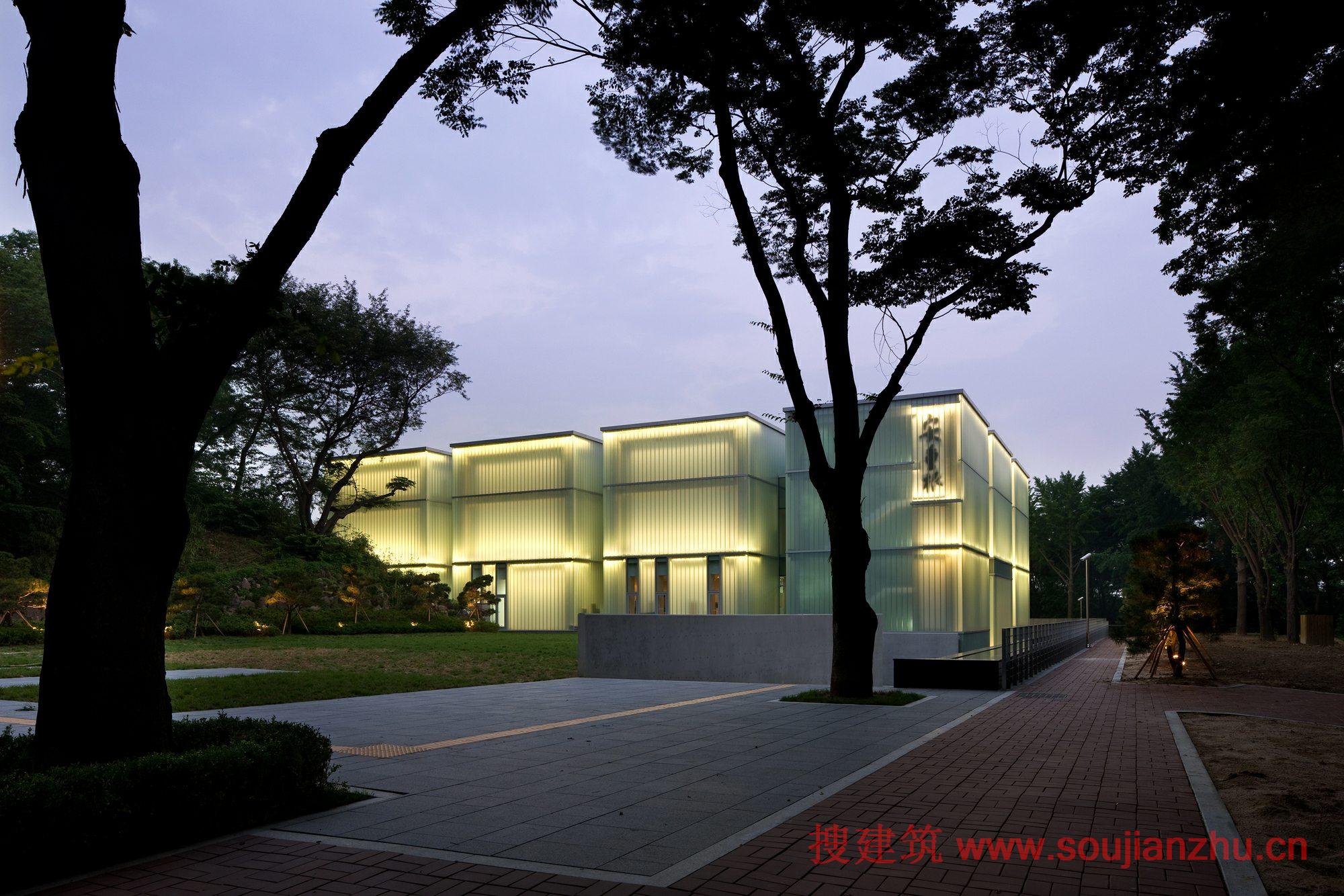As a classic example of U profile glass applied in cultural architecture, the Ahn Jung-geun Memorial Hall in Seoul, South Korea, has become an iconic contemporary building through the in-depth integration of material properties and historical narration.
I. Design Concept and Symbolic Meaning
Designed by D Lim Architects, the memorial hall features a main structure composed of an array of 12 U profile glass columns, symbolizing the 12 members of the “Finger-Cutting Alliance” founded by Ahn Jung-geun. These glass columns rise from the sunken base, matching the height of surrounding trees—this design not only blends the building into the natural environment but also creates a “glowing monument” visual effect through the translucent material.
The outer layer of U profile glass undergoes a matte finish, with light transmittance controlled between 45% and 65%. This not only ensures indoor lighting but also prevents exhibits from being damaged by direct sunlight, while metaphorically representing the vagueness and eternity of historical memories.
II. Analysis of U profile glass Technology Application
Material Selection and Structure
The outer layer adopts colored glazed U profile glass with a thickness of 8mm. A double-layer insulated structure (outer U profile glass + inner polycarbonate panel) is used to achieve thermal insulation and soundproofing performance. This combination reduces the curtain wall’s heat transfer coefficient to 2.35W/(m²・K) and achieves a sound insulation capacity of 38dB, effectively blocking urban noise and maintaining stable indoor temperature and humidity.
Light Narrative and Dynamic Lighting
LED light strips are embedded inside the glass. At night, programmed control creates gradient colors to simulate the timeline of historical events. For instance, red light reflects the assassination scene, blue symbolizes the depth of the independence movement, and white represents the inheritance of Ahn Jung-geun’s spirit.
This dynamic lighting system, combined with the frosted texture of the glass surface, projects flowing historical images on the building’s facade, making it a key part of Seoul’s nightscape.
Structural Innovation and Sustainability
The U profile glass columns adopt modular prefabrication technology. The assembly of glass and aluminum alloy frames is completed in the factory, and the columns are fixed to the concrete base via bolt connections on-site—this shortens the construction period by 30% compared to traditional curtain walls.
The glass material has a recyclability rate of 90%, and 70% recycled glass is used in the production process, meeting South Korea’s green building certification standards.
III. Cultural Value and Social Impact
Materialized Expression of Historical Memory
The memorial hall is located adjacent to the site of a wartime shrine from Japan’s colonial period. The translucency of U profile glass not only blurs the building’s boundaries but also juxtaposes historical scars with the newly built memorial through light and shadow contrast.
When visitors walk through the array of glass columns, the historical timeline embedded in the ground interacts with the text projections on the glass, reinforcing the narrative theme of “Remembrance and Reflection.”
Architectural Awards and Industry Recognition
The project won the 2010 Seoul Architecture Grand Prize and the 2011 Korean Institute of Architects “Best 7″ Award. Its innovation lies in elevating U profile glass from a functional material to a cultural carrier. The jury commented: “The array of glass columns is not only a structural innovation but also an architectural poem that writes history with light.”
Open Design of Public Space
The transparency of the glass curtain wall seamlessly connects the memorial hall’s internal exhibition space with the external urban landscape. During visits, audiences can see Namsan Forest and Seoul’s skyline through the glass—this “internal-external integration” design strategy breaks the closed nature of traditional memorial halls and reflects South Korean society’s open attitude toward historical narration.
IV. Technical Challenges and Solutions
Adaptability to Mountain Terrain
The memorial hall is situated on the hillside of Namsan Mountain, with a terrain undulation of 8 meters. The design team adopted an adjustable aluminum alloy bracket system and used BIM technology to accurately calculate the tilt angle of each glass column, ensuring the overall flatness error of the curtain wall is less than 2mm. Meanwhile, drainage grooves are installed at the bottom of the glass columns to effectively solve rainwater accumulation issues.
Durability Under Extreme Climatic Conditions
Seoul experiences a minimum temperature of -15℃ in winter and a maximum temperature of 35℃ in summer, with drastic humidity changes. The U profile glass uses double-layer sealing strips (EPDM + silicone), and desiccants are filled in the air layer to prevent condensation. After 10 years of monitoring, the curtain wall’s airtightness still meets the European standard Class 4.
Preservation Requirements for Historical Relics
Historical relics displayed in the hall, such as Ahn Jung-geun’s blood-written manuscripts, are sensitive to light. The design team added a Low-E coating to the inner side of the U profile glass, controlling ultraviolet transmittance below 15%. At the same time, a UV-free LED lighting system is used to ensure the relic preservation environment meets the standards of the International Council of Museums (ICOM).
V. Industry Insights and Future Outlook
The practice of the Ahn Jung-geun Memorial Hall shows that U profile glass can break the functional boundaries of traditional building materials through in-depth integration of material composites (colored glaze + polycarbonate), technology integration (LED lighting + intelligent control), and historical narration.
In the future, with the commercial application of photovoltaic U profile glass (such as Yongyu’s UBIPV series) and bio-based sealants (such as linseed oil resin developed by Germany’s LAMBERTS), the potential of this material in cultural heritage protection and sustainable architecture will be further unleashed.
This case provides a new idea for the renovation of historical buildings: using modern material language to interpret historical spirit and find a balance between protection and innovation.
Post time: Oct-17-2025
